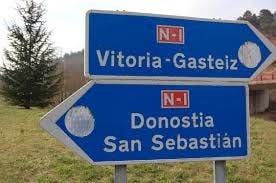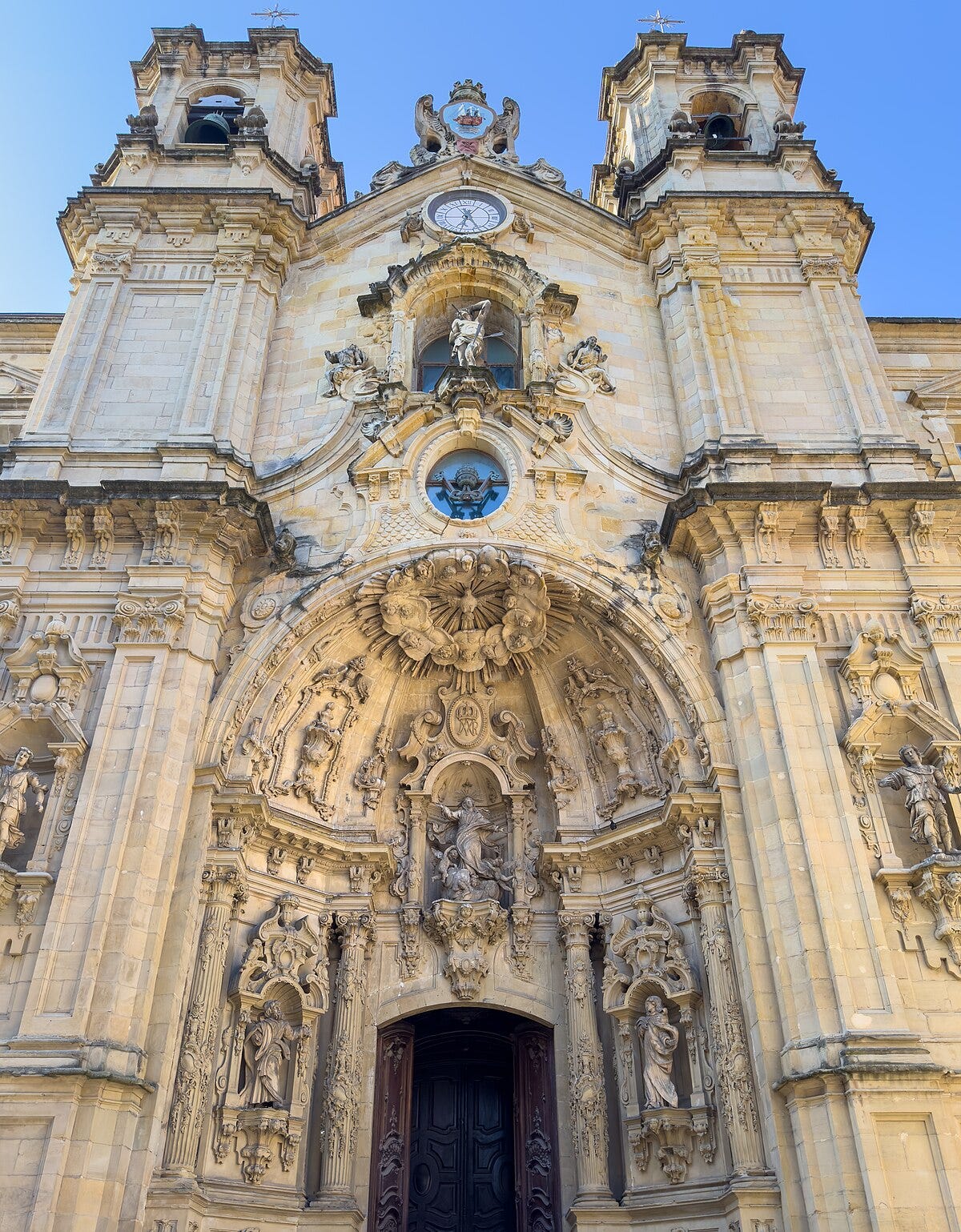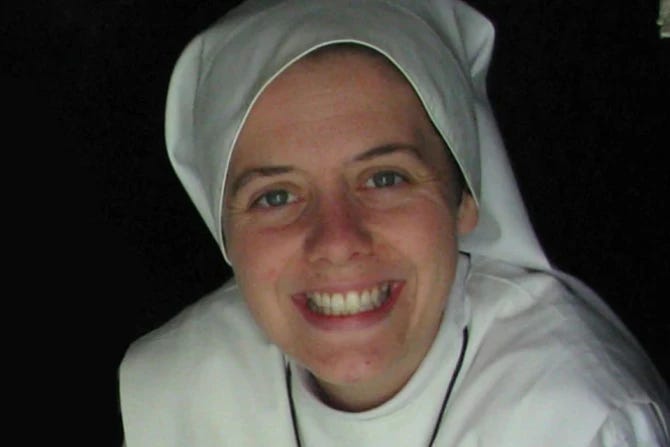Saint Sebastian, and Other Saints Among Us
By now, you should be able to tell that I love the city of San Sebastián. It is one of my favorite places in Spain, and, in fact, the world.
What of the name? San Sebastián in Spanish, and Donostia in Basque. In today’s multilingual Spain, it is common to see both names on highway signs.
But when it comes to mind, I think of this church,
and the statue under the clock of the Basilica of Santa Maria,
of Saint Sebastian writhing in agony.
Saint Sebastian was martyred in the 3rd Century during the Diocletian Persecution of Christians. Sebastian, who had concealed his faith, was detected as a Christian in 286. It was then that Diocletian ordered that he be led to a field, and there to be bound to a stake, where he would be shot with arrows. After the archers did their dirty task, it was said, he was as full of arrows, as an urchin, full of pricks, and left there for dead.
Miraculously, he did not die. A Roman Christian woman, Irene, went to retrieve his body to bury it, only to discover that he was still alive. She brought him back to her house and nursed him back to health.
After his recovery, Sebastian stood by a staircase where the emperor was passing and confronted Diocletian about his cruelties against Christians. This upfront from a person whom he supposed was dead, greatly astonished and angered the emperor. Incensed, he gave orders for Sebastian to be seized and beaten to death with cudgels, and have his body thrown into the common sewer. Another holy woman named Lucina, inspired by a vision, privately removed the body and buried it in the catacombs at the entrance of the cemetery of Calixtus, where now stands the Basilica of St. Sebastian.
Saint Sebastian, in addition to being the beautiful Spanish city, is the genesis of the name of one of the main characters of the great 20th Century novel by Evelyn Waugh, Brideshead Revisited. In the book, Lord Sebastian Flyte suffers great torment from his alcoholism and immorality, but he is ultimately reconciled to his faith by a group of monks in North Africa.
The city, and in fact, the statue above, also play an important role in my first book, Holy Ghost. It occurs on one of the final pages of the novel. It is in this scene that one of the main characters, Montserrat Costa, arrives at the funeral of her beloved, Xavi Bidertea, who had just been murdered in Barcelona, near the end of the Spanish Civil War.
Finally, the procession arrived at the basilica. As she reached the steps, Montse looked up at the statue of Saint Sebastian high above the church entrance. The Saint was shown at the moment of his martyrdom. He was tied to a post and pierced with arrows. Seeing the statue, for a moment she lost her breath, painfully recalling the moment of Xavi’s death.
And then, minutes later in the church, as a fellow priest eulogizes Xavi
And one last thing. It is something which connects Xavi to this city and to the events that have torn this country apart for the last few years. High above the entrance of this church is the statue of Saint Sebastian, the patron of this city. He is bound, tied to a post, pierced with arrows. He was martyred for all time, and after his martyrdom, Saint Sebastian became the saint called for intercession against plagues.
Xavi was also martyred. He was bound and tied to a church pillar, pierced not with arrows, but with bullets. Join with me to call on Xavi’s memory for intercession against the plague that descended on this country. There would be no better way to remember Xavi.
May God rest his soul.
Monsignor Latour stepped down from the pulpit and the funeral ended with the choir singing the last verses from Psalm 23:
The Lord is my shepherd; I shall not want.
He maketh me to lie down in green pastures: he leadeth me beside the still waters.
He restoreth my soul: he leadeth me in the paths of righteousness for his name’s sake.
Yea, though I walk through the valley of the shadow of death, I will fear no evil: for thou art with me; thy rod and thy staff they comfort me.
The crowd left the church; all were subdued and moved, and most of them openly weeping.
Lest you think that becoming a saint is something from the foggy past, it is not. Numerous Spaniards have been canonized as saints in the 20th Century, including over 1,000 martyrs of the Spanish Civil War.
So what are the attributes of those that are named saints in the Catholic Church?
1. Heroic Virtue
Saints demonstrate extraordinary virtue in their daily lives, including:
Faith – Unwavering belief in God.
Hope – Trust in divine providence, even in suffering.
Charity (Love) – Selfless love for God and others.
Humility – Recognizing that all goodness comes from God.
Patience – Endurance through hardships.
Obedience – Submission to God’s will.
2. Holiness and Union with God
Saints live lives of prayer, contemplation, and devotion.
Many experience mystical union with God (e.g., visions, ecstasies, miracles).
3. Sacrifice and Suffering
Many saints endure persecution, martyrdom, illness, or extreme hardships for their faith.
They embrace suffering with joy and trust in God.
4. Apostolic Zeal and Evangelization
Saints spread the Gospel through preaching, missionary work, or teaching.
They lead others to Christ through example and service.
5. Acts of Charity and Mercy
Helping the poor, sick, and marginalized (e.g., St. Teresa of Calcutta).
Founding schools, hospitals, or religious communities.
6. Miracles
Many saints are associated with miracles during their lives or after death.
Miracles are often required for canonization (except in the case of martyrs).
7. Martyrdom (for Some Saints)
Dying for the faith is considered the ultimate witness to Christ, and martyrs are often canonized without the need for miracles.
All of this brings to me the real point of this article. Sister Clare Crockett.
Crockett was born on Nov. 14, 1982, in Derry, Northern Ireland. She was a charismatic and fun-loving teenager, who had a talent for acting and appeared on a television show on Channel 4 in the U.K.; the young girl was so gifted, that she attracted interest from Nickelodeon. Clare was a typical teen of our time, who favored partying, drinking, and smoking.
But all of that became in her past when she attended a Holy Week retreat in Spain at the age of 17 with the Servant Sisters of the Home of the Mother. It was an event that transformed her life.
She recalled later in her personal testimony, that when she arrived in Spain, she was “very superficial and a wild child”. But that began to change when she took part in the Good Friday adoration of the cross and the kissing of the feet of Jesus.
“I do not know how to explain exactly what happened. I did not see the choirs of angels or a white dove come down from the ceiling and descend on me, but I had the certainty that the Lord was on the cross, for me,” she recalled.
“And along with that conviction, I felt a great sorrow … and prayed the Stations of the Cross. When I returned to my pew, I already had imprinted in me something that was not there before. I had to do something for Him, who had given his life for me.”
Despite initial struggles to leave behind a life of “superficiality and sin”, she entered religious life in 2001 in Spain, making her first vows in 2006 and her final vows in 2010.
Sister Clare died on April 16, 2016, when a 7.8-magnitude earthquake crushed the school in Playa Prieta, Ecuador, where she was teaching music.
Known for her infectious joy and dedication to others, she served in Spain, the United States, and Ecuador. The case for sainthood of Sister Clare Crockett formally began earlier this year with a ceremony at the Cathedral of Alcalá de Henares in Madrid, Spain.
Finally, when I look at the young nun’s radiant face,
I am reminded of something the great English writer, Graham Greene, said about his faith. Probably, referring to his great friend, Spanish priest Leopoldo Duran,
Greene commented that he was sure there was a God when he met people who were so obviously good that, it seemed to him, their goodness could have only come from God.
Happy Ashe Wednesday and God bless the soul of Sister Clare.










